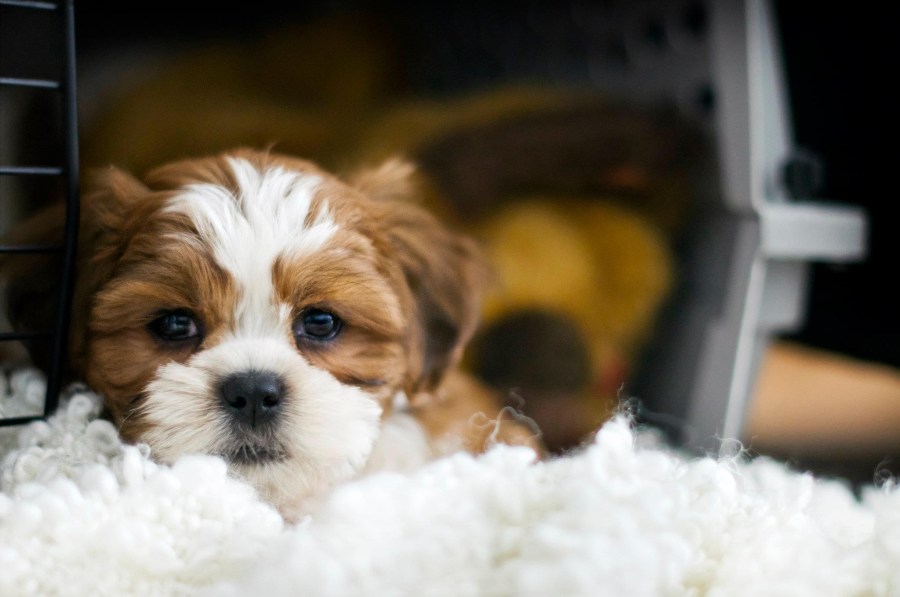How to Crate Train Your New Puppy

Crate training is a great way to help your new puppy become house trained, acclimate to their new habitat, and establish a consistent routine. Training your puppy to spend time in their crate takes advantage of a dog’s natural den instinct, providing a safe place for fido to rest and recharge.
Each puppy goes through crate training at a different rate. Some puppies are completely crate trained in just a few days, while others may take a few months to feel comfortable spending time in their crate. While the time it takes can vary, the process itself is simple.
Crate Training Prep
Before you begin crate training, set up your crate in your home’s living space, with several items inside that are familiar to your puppy. It’s a good idea to line the crate with a blanket your puppy likes, and place a few of your puppy’s toys around or within the crate. This will help the puppy immediately begin to form positive associations with the crate.
You’ll also want to choose a crate that makes the most sense for your puppy and household. Metal wire crates are popular for in-home crate training. They are easy to set up and disassemble, and they are the most secure crate option. Additionally, metal crates are easy to clean and allow you to easily see your puppy when they’re in the crate.
Pet owners who travel often might want to consider getting a plastic dog crate. These crates are required for plane travel with a puppy. Plastic crates can also be preferable to shy or easily frightened puppies, because their solid sides provide a higher level of privacy.
Introduce Your Puppy to The Crate
Once you’ve set up the crate in your living space with a some familiar items inside, introduce your puppy to the crate by placing a few treats around and inside it. Bring your puppy into the room with you, but don’t force them to go near the crate right away. Your puppy will eventually find the treats inside the crate. When they do, toss a few more inside for them to enjoy.
Continue this pattern two or three times per day until your puppy approaches the crate confidently and comfortably. This can take as little as one or two days, or as long as a few weeks, depending on your puppy’s temperament. Consider placing one of your puppy’s favorite toys in the crate in addition to the treats. This will teach the puppy to associate the crate with food and fun, letting them know that the crate isn’t a frightening or threatening place.
At this point, don’t be discouraged if your puppy doesn’t go all the way into the crate on their own. The goal of this step is simply to begin the process of familiarizing your puppy with the crate. Be sure to avoid forcing your puppy to enter before they are ready, as this can cause them to develop negative associations with the crate.
Mealtime in the Crate
When your puppy seems comfortable being around the crate, begin serving them their meals near it. After serving your puppy meals next to the crate for two days, begin placing the food just inside the crate. After the first time doing this, move the food slightly farther into the crate with each successive meal. If your dog begins to show signs of stress or anxiety, move the food back to a position where they are comfortable, and wait at least a day before moving it farther in.
When your puppy is able to comfortably go all the way into the crate to eat, close the crate door while they are eating. Once they finish the meal, open the door to let them exit. Continue to do this over the next few days, slightly extending the time the door is closed with each meal. This will allow the puppy to become comfortable in a closed crate.
Short Stays
After establishing a routine of eating meals in the closed crate, begin to have your puppy spend short periods of time enclosed in the crate with you in the room. First, entice them to enter by leaving a treat or a favorite toy inside the crate and using a command, many people use “crate” or “kennel,” to tell your puppy to enter. When they are completely in the crate, close the door and leave them alone for 10 minutes, while staying in the same room.
From there, slowly increase the time your puppy spends in the crate by a few minutes at a time, until they are comfortable spending between 30-40 minutes in the crate at a stretch. As they get more comfortable, leave the room for increasing amounts of time, so your puppy gets used to staying the crate when you’re not in sight. Once your puppy is confident spending time in their crate without you around, you can begin to leave the house for short periods of time while they’re crated.
Overnight Stays
Once you’ve gotten to this point, your puppy should feel comfortable being crated for short periods of time with you either at home or out of the house. If they show no signs of anxiety, they’re ready to begin overnight crate stays.
The first few overnight stays should be in a space close to you. Being close to you at night will help ease any anxiety your puppy may have about an overnight crate stay. Once your puppy gets more comfortable, you can move the crate back to its preferred location. About ten minutes before you go to bed, use a command and a treat to have your puppy enter the crate. Get your puppy used to overnight stays with you close by before moving the crate back to the living area at night.





